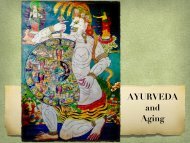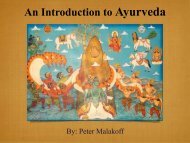How Thoreau's Walden Pond Mixed with the Ganges and Yoga Came to America with Swami Vivekananda
One early morning in 1846, during the coldest days of a New England winter, Henry David Thoreau looked out the window of his small cabin on Walden Pond and saw men cutting its ice into blocks. That ice was hauled by horse to a railroad that ran across the western edge of Walden Pond, packed into a boxcar, taken to Boston and loaded onto a clipper ship that sailed to Calcutta, India, arriving about four months later. Once there, that ice was purchased by grateful members of the East India Company. Thoreau had witnessed a small part of the global ice trade between New England and India that took place during the latter part of the nineteenth century. When Thoreau considered the ice trade, his vision sailed on metaphors far beyond the scope of business. The waters he imagined flowed both east and west and carried not just natural elements, but culture, religion and philosophy as well. He envisioned that after arriving in Calcutta, the New England ice of Walden Pond would eventually melt and run downhill where it would join with the sacred water of the Ganges. He wrote in Walden: "It appears that the sweltering inhabitants of Charleston and New Orleans, of Madras and Bombay and , drink at my well. In the morning I bathe my intellect in the stupendous and cosmogonal philosophy of the , since whose composition years of the gods have elapsed, and in comparison with which our modern world and its literature seem puny and trivial; and I doubt if that philosophy is not to be referred to a previous state of existence, so remote is its sublimity from our conceptions. I lay down the book [Bhagavad-Gita] and go to my well for water, and lo! there I meet the servant of the Bramin, priest of and and who still sits in his temple on the Ganges reading the , or dwells at the root of a tree with his crust and water jug. I meet his servant come to draw water for his master, and our buckets as it were grate together in the same well. The pure Walden water is mingled with the sacred water of the Ganges." This book tells the story of these waters . . .
One early morning in 1846, during the coldest days of a New England winter, Henry David Thoreau looked out the window of his small cabin on Walden Pond and saw men cutting its ice into blocks. That ice was hauled by horse to a railroad that ran across the western edge of Walden Pond, packed into a boxcar, taken to Boston and loaded onto a clipper ship that sailed to Calcutta, India, arriving about four months later. Once there, that ice was purchased by grateful members of the East India Company. Thoreau had witnessed a small part of the global ice trade between New England and India that took place during the latter part of the nineteenth century.
When Thoreau considered the ice trade, his vision sailed on metaphors far beyond the scope of business. The waters he imagined flowed both east and west and carried not just natural elements, but culture, religion and philosophy as well. He envisioned that after arriving in Calcutta, the New England ice of Walden Pond would eventually melt and run downhill where it would join with the sacred water of the Ganges. He wrote in Walden: "It appears that the sweltering inhabitants of Charleston and New Orleans, of Madras and Bombay and , drink at my well. In the morning I bathe my intellect in the stupendous and cosmogonal philosophy of the , since whose composition years of the gods have elapsed, and in comparison with which our modern world and its literature seem puny and trivial; and I doubt if that philosophy is not to be referred to a previous state of existence, so remote is its sublimity from our conceptions.
I lay down the book [Bhagavad-Gita] and go to my well for water, and lo! there I meet the servant of the Bramin, priest of and and who still sits in his temple on the Ganges reading the , or dwells at the root of a tree with his crust and water jug. I meet his servant come to draw water for his master, and our buckets as it were grate together in the same well. The pure Walden water is mingled with the sacred water of the Ganges."
This book tells the story of these waters . . .
You also want an ePaper? Increase the reach of your titles
YUMPU automatically turns print PDFs into web optimized ePapers that Google loves.
Gurudeva<br />
“Gurudeva is a generic address <strong>to</strong> a guru in Hinduism.<br />
Guru is a Sanskrit term for "teacher" or "master,” especially in Indian religions.<br />
The Hindu guru-shishya tradition is <strong>the</strong> oral tradition or religious doctrine or experiential<br />
wisdom transmitted from teacher <strong>to</strong> student.<br />
The importance of finding a guru who can impart transcendental knowledge (vidyā)<br />
is emphasized in Hinduism. One of <strong>the</strong> main Hindu texts, <strong>the</strong> Bhagavad<br />
Gita, is a dialogue between God in <strong>the</strong> form of Krishna <strong>and</strong> his friend Arjuna, a<br />
Kshatriya prince who accepts Krishna as his guru on <strong>the</strong> battlefield, prior <strong>to</strong> a<br />
large battle. Not only does this dialogue outline many of <strong>the</strong> ideals of Hinduism,<br />
but <strong>the</strong>ir relationship is considered an ideal one of Guru-Shishya. In <strong>the</strong> Gita,<br />
Krishna speaks <strong>to</strong> Arjuna of <strong>the</strong> importance of finding a guru:<br />
Acquire <strong>the</strong> transcendental knowledge from a Self-realized master by humble reverence, by<br />
sincere inquiry, <strong>and</strong> by service. The wise ones who have realized <strong>the</strong> Truth will impart <strong>the</strong><br />
Knowledge <strong>to</strong> you.<br />
In <strong>the</strong> sentence mentioned above, guru is used more or less interchangeably<br />
<strong>with</strong> satguru (literally: true teacher), paratpar Guru <strong>and</strong> satpurusha. <strong>How</strong>ever,<br />
<strong>the</strong>re is a marked difference between <strong>the</strong>m in <strong>the</strong> spiritual context. The disciple<br />
of a guru is called a śiṣya or chela. Often a guru lives in an ashram or in a gurukula<br />
(<strong>the</strong> guru's household), <strong>to</strong>ge<strong>the</strong>r <strong>with</strong> his disciples. The lineage of a guru,<br />
spread by disciples who carry on <strong>the</strong> guru's message, is known as <strong>the</strong> guru parampara,<br />
or disciplic succession.<br />
The role of <strong>the</strong> guru continues in <strong>the</strong> original sense of <strong>the</strong> word in such<br />
Hindu traditions as <strong>the</strong> Vedānta, yoga, tantra <strong>and</strong> bhakti schools. Indeed, it is<br />
now a st<strong>and</strong>ard part of Hinduism that a guru is one's spiritual guide on earth. In<br />
some more mystical traditions it is believed that <strong>the</strong> guru could awaken dormant<br />
spiritual knowledge <strong>with</strong>in <strong>the</strong> pupil. The act of doing this is known as shaktipat.<br />
In Hinduism, <strong>the</strong> guru is considered a respected person <strong>with</strong> saintly qualities<br />
who enlightens <strong>the</strong> mind of his or her disciple, an educa<strong>to</strong>r from whom one receives<br />
<strong>the</strong> initia<strong>to</strong>ry mantra, <strong>and</strong> one who instructs in rituals <strong>and</strong> religious ceremonies.<br />
The Vishnu Smriti <strong>and</strong> Manu Smriti regard <strong>the</strong> teacher <strong>and</strong> <strong>the</strong> mo<strong>the</strong>r<br />
<strong>and</strong> fa<strong>the</strong>r as <strong>the</strong> most venerable influences on an individual.<br />
In Indian culture, a person <strong>with</strong>out a guru or a teacher (acharya) was once<br />
looked down on as an orphan or unfortunate one. The word anatha in Sanskrit<br />
means "<strong>the</strong> one <strong>with</strong>out a teacher." An acharya is <strong>the</strong> giver of gyan (knowledge)<br />
in <strong>the</strong> form of shiksha (instruction). A guru also gives diksha initiation which is<br />
<strong>the</strong> spiritual awakening of <strong>the</strong> disciple by <strong>the</strong> grace of <strong>the</strong> guru. Diksha is also<br />
considered <strong>to</strong> be <strong>the</strong> procedure of bes<strong>to</strong>wing <strong>the</strong> divine powers of a guru upon<br />
<strong>the</strong> disciple, through which <strong>the</strong> disciple progresses continuously along <strong>the</strong> path <strong>to</strong><br />
divinity.<br />
The concept of <strong>the</strong> "guru" can be traced as far back as <strong>the</strong> early Upanishads,<br />
where <strong>the</strong> idea of <strong>the</strong> Divine Teacher on earth first manifested from its early<br />
Brahmin associations.<br />
The guru-shishya tradition is <strong>the</strong> transmission of teachings from a guru<br />
(teacher,) <strong>to</strong> a 'śiṣya' (disciple). In this relationship, subtle <strong>and</strong> advanced knowledge<br />
is conveyed <strong>and</strong> received through <strong>the</strong> student's respect, commitment, devotion<br />
<strong>and</strong> obedience. The student eventually masters <strong>the</strong> knowledge that <strong>the</strong> guru<br />
embodies.”<br />
– Wikipedia, The Free Encyclopedia


















